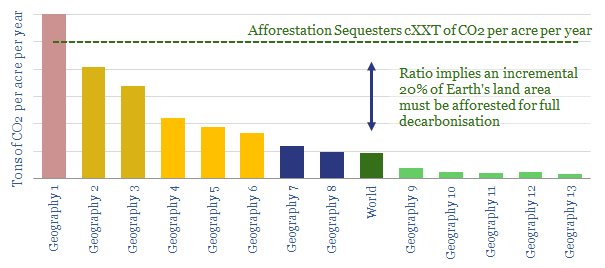In 2019, Shell pledged $300M of new investment into forestry. TOTAL, BP and Eni are also pursuing similar schemes. But can they move the needle for CO2? In order to answer this question, we have tabulated our ‘top five’ facts about forestry. We think Oil Majors may drive the energy transition most effectively via developing better energy technologies in their portfolios.
[restrict]
(1). Forests should sequester 5T of CO2 per acre per annum, which is the average figure in half-a-dozen technical papers that we reviewed. However, the rates in these studies vary from 1-25 Tons per acre per annum, depending upon the species, the latitude and the rate of harvesting. Forests grow fastest in their early stages, and so paradoxically, to maximise CO2 sequestration, it may be necessary to cut them down periodically (and then re-plant).
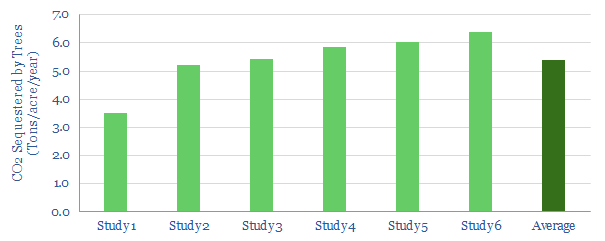
(2). The world emits 1T of CO2 per acre per annum, which means that for forestry to absorb all of the world’s CO2 emissions, an incremental 20% of the world’s land mass must be given over to planting new forests. An extremely high number. Global carbon emissions run at 34bn tons per annum, while the world’s total land area is 37bn acres (c150M sq km).
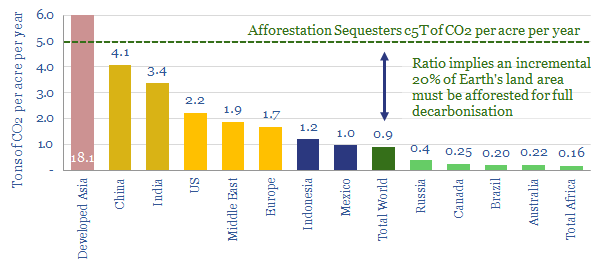
(3). It matters where you plant. The chart above also shows a problematic skew in the world’s carbon emissions. If developed Asian countries (Japan, Korea, Singapore) wanted to offset all of their emissions by planing forests, they would need to access land areas that are c3.5x larger than their entire territories. Likewise, India and China would need to access areas equivalent to 60-80% of their own borders. To move the needle, large new forests would need to be planted in the countries on the right hand side of the chart. For the full data series, please download our data-file.
There are select opportunities in the mix, which Oil Majors can pursue. Perhaps the largest come from irrigating and afforesting desert areas. Not only are these areas large, but forests in hot areas have a tendency to grow more quickly and release more moisture, which in turn seeds clouds, which in turn reflects more sunlight and cools the planet.
(4). Environmental question marks? Forests clearly sequester CO2, but the precise climate science is surprisingly complex. Leaves absorb more sunlight than other types of land cover, increasing albedo, and warming the planet mildly. Trees can also release compounds called isoprenes, which reacts with nitrogen oxides in the air to form ozone (a greenhouse gas), while lengthening the lifespan of atmospheric methane (another greenhouse gas). Similarly, trees in tropical forests can seem to act as a conduit for soil to convey methane into the atmosphere. This deepens the need for “the right kind” of forestry investment, based on science.
(5). Capital may be better spent elsewhere? Most of the estimates we have encountered point to $20-100/ton of costs for sequestering CO2 using forests. This is competitive with other current forms of CCS (chart below, data here). However, we are also researching next-generation carbon capture technologies, which are much more competitive, below $20/ton.
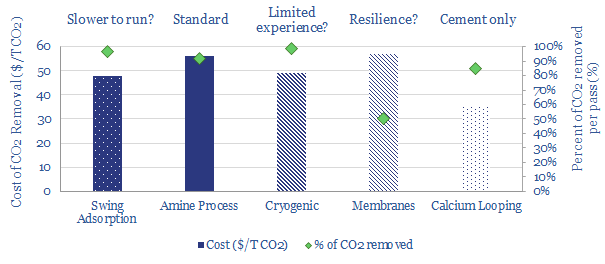
To illustrate the same point another way, photosynthesis’s energy efficiency is around 0.5-1%, compared to today’s solar cells at c17% and next-generation perovskites reaching c35% (chart below). So ramping up next-genration solar could yield greater decarbonisation per unit of land area.
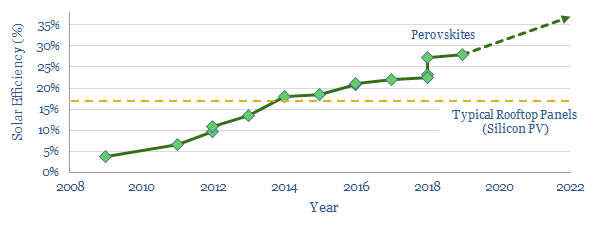
While we think Majors have a deep role to play in driving the energy transition, it will most likely be though game-changing technologies, which also unlock multi-billion dollar economic opportunities, per our recent note here.
References
Caldecott, B., Lomax, B. & Workman, M., (2015). Stranded Carbon Assets and Negative Emissions Technologies Working Paper. Stranded Assets Programme.
Gorte, R. (2009). U.S. Tree Planting for Carbon Sequestration. Congressional Research Service
Lenton, T.M., 2010. The potential for land-based biological CO2 removal to lower future atmospheric CO2 concentration. Carbon Management 1(1), 145–160.
Lewandrowski, J., Peters, M. & Jones, C. (2004). Economics of Sequestering Carbon in the U.S. Agricultural Sector, USDA Economic Research Service, Technical Bulletin TB-1909
Popkin, G., (2019). How much can forests fight climate change? Nature 565, 280-282
U.S. Environmental Protection Agency (2005). Greenhouse Gas Mitigation Potential in U.S. forestry and Agriculture, EPA 430-R-05-006, Washington, DC.
BP (2019). BP Statistical Review of World Energy
[/restrict]

